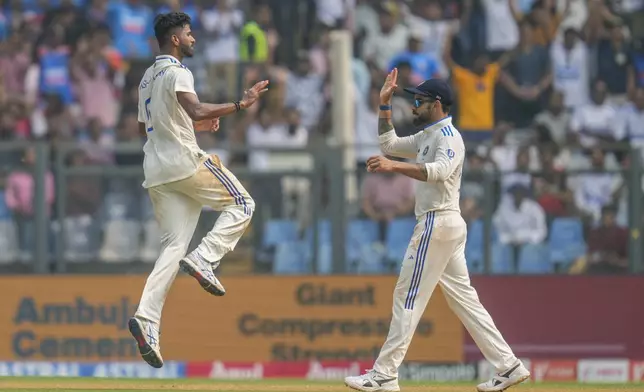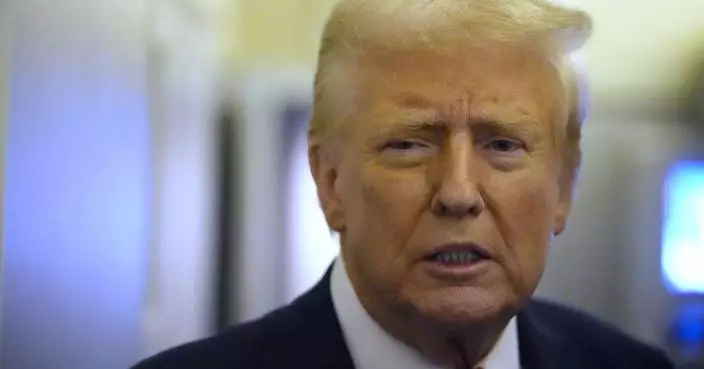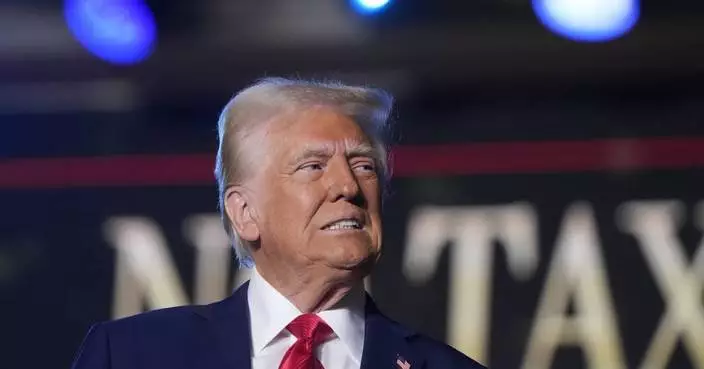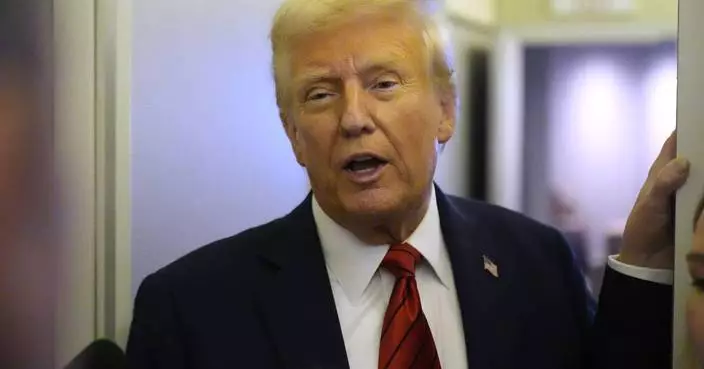MUMBAI, India (AP) — Fourteen wickets fell on the opening day as India's cricketers struggled to 86-4 in reply to New Zealand’s 235 all out in the third test on Friday.
India lost three wickets for six runs in seven deliveries just before stumps were drawn.
Click to Gallery
India's captain Rohit Sharma, left, Rishab Pant, center, celebrates the dismissal of New Zealand's captain Tom Latham, right, during the first day of the third cricket test match between India and New Zealand at Wankhede Stadium, in Mumbai, India, Friday, Nov. 1, 2024.(AP Photo/Rajanish Kakade)
New Zealand's Daryl Mitchell plays a shot during the first day of the third cricket test match between India and New Zealand at Wankhede Stadium, in Mumbai, India, Friday, Nov. 1, 2024.(AP Photo/Rajanish Kakade)
India's Washington Sundar, left, and Virat Kohli celebrates the dismissal of New Zealand's captain Tom Latham during the first day of the third cricket test match between India and New Zealand at Wankhede Stadium, in Mumbai, India, Friday, Nov. 1, 2024.(AP Photo/Rajanish Kakade)
India's Washington Sundar, left, and Virat Kohli celebrates the dismissal of New Zealand's captain Tom Latham during the first day of the third cricket test match between India and New Zealand at Wankhede Stadium, in Mumbai, India, Friday, Nov. 1, 2024.(AP Photo/Rajanish Kakade)
New Zealand's captain Tom Latham is bowled out during the first day of the third cricket test match between India and New Zealand at Wankhede Stadium, in Mumbai, India, Friday, Nov. 1, 2024.(AP Photo/Rajanish Kakade)
New Zealand's Will Young watches at the ball after playing a shot during the first day of the third cricket test match between India and New Zealand at Wankhede Stadium, in Mumbai, India, Friday, Nov. 1, 2024.(AP Photo/Rajanish Kakade)
India's captain Rohit Sharma, left, Rishab Pant, center, celebrates the dismissal of New Zealand's captain Tom Latham, right, during the first day of the third cricket test match between India and New Zealand at Wankhede Stadium, in Mumbai, India, Friday, Nov. 1, 2024.(AP Photo/Rajanish Kakade)
India's Washington Sundar, left, and Virat Kohli celebrates the dismissal of New Zealand's captain Tom Latham during the first day of the third cricket test match between India and New Zealand at Wankhede Stadium, in Mumbai, India, Friday, Nov. 1, 2024.(AP Photo/Rajanish Kakade)
New Zealand's Will Young bats during the first day of the third cricket test match between India and New Zealand at Wankhede Stadium, in Mumbai, India, Friday, Nov. 1, 2024.(AP Photo/Rajanish Kakade)
New Zealand's Daryl Mitchell watches at the ball after playing a shot during the first day of the third cricket test match between India and New Zealand at Wankhede Stadium, in Mumbai, India, Friday, Nov. 1, 2024.(AP Photo/Rajanish Kakade)
Washington Sundar, center, Virat Kohli, right, and Ravindra Jadeja celebrates the dismissal of New Zealand's captain Tom Latham during the first day of the third cricket test match between India and New Zealand at Wankhede Stadium, in Mumbai, India, Friday, Nov. 1, 2024.(AP Photo/Rajanish Kakade)
India's Washington Sundar, left, and Virat Kohli celebrates the dismissal of New Zealand's Rachin Ravindra during the first day of the third cricket test match between India and New Zealand at Wankhede Stadium, in Mumbai, India, Friday, Nov. 1, 2024.(AP Photo/Rajanish Kakade)
India's captain Rohit Sharma attends practice session before third test match against New Zealand in Mumbai, India, Thursday, Oct. 31, 2024. (AP Photo/Rajanish Kakade)
New Zealand's Rachin Ravindra, left and Daryl Mitchell take part in a practice session before the third test match against India, in Mumbai, India, Thursday, Oct. 31, 2024. (AP Photo/Rajanish Kakade)
India's Virat Kohli participates in a practice session before third test match against New Zealand in Mumbai, India, Thursday, Oct. 31, 2024.(AP Photo/Rajanish Kakade)
New Zealand's Mitchell Santner takes part in a practice session before the third test match against India, in Mumbai, India, Thursday, Oct. 31, 2024. (AP Photo/Rajanish Kakade)
Yashasvi Jaiswal, who scored 30 off 52 balls, was bowled by left-arm spinner Ajaz Patel while trying a reverse sweep.
Patel then trapped nightwatchman Mohammed Siraj lbw for a golden duck before Virat Kohli was run out for four in the next over. Going for a quick single, he failed to beat Rachin Ravindra’s direct hit from mid-on.
Shubman Gill finished unbeaten on 31, with Rishabh Pant 1 not out.
Earlier, Ravindra Jadeja picked up his 14th five-wicket haul in tests as New Zealand lost seven wickets for 76 runs. Jadeja claimed 5-65 while Washington Sundar took 4-81.
Daryl Mitchell top-scored with 82 and Will Young made 71 after New Zealand had won the toss and opted to bat.
Akash Deep trapped in-form opener Devon Conway lbw for four before captain Tom Latham added 44 runs with Young for the second wicket.
Getting sharp purchase against the left-handers, Sundar bowled Latham for 28 and Ravindra for five.
In hot, humid conditions, Young was caught at slip off Jadeja in the 45th over. Then, three balls later he bowled Tom Blundell for a duck.
Jadeja then bowled Glenn Phillips for 17 just before the tea break.
After the interval, Jadeja trapped Ish Sodhi lbw for seven and bowled Matt Henry for a two-ball duck. Sundar then had Mitchell caught at first slip.
Sundar finished things off by removing Patel lbw for seven.
India’s innings then began in attacking fashion, with Rohit Sharma scoring 18 before he was caught at second slip off Henry. He had been dropped on 15.
Jaiswal and Gill then put on 53 for the second wicket ahead of India's late collapse.
New Zealand won the first two tests in Bengaluru and Pune by eight wickets and 113 runs respectively, registering a landmark first test-series win in India.
AP cricket: https://apnews.com/hub/cricket

New Zealand's Daryl Mitchell plays a shot during the first day of the third cricket test match between India and New Zealand at Wankhede Stadium, in Mumbai, India, Friday, Nov. 1, 2024.(AP Photo/Rajanish Kakade)
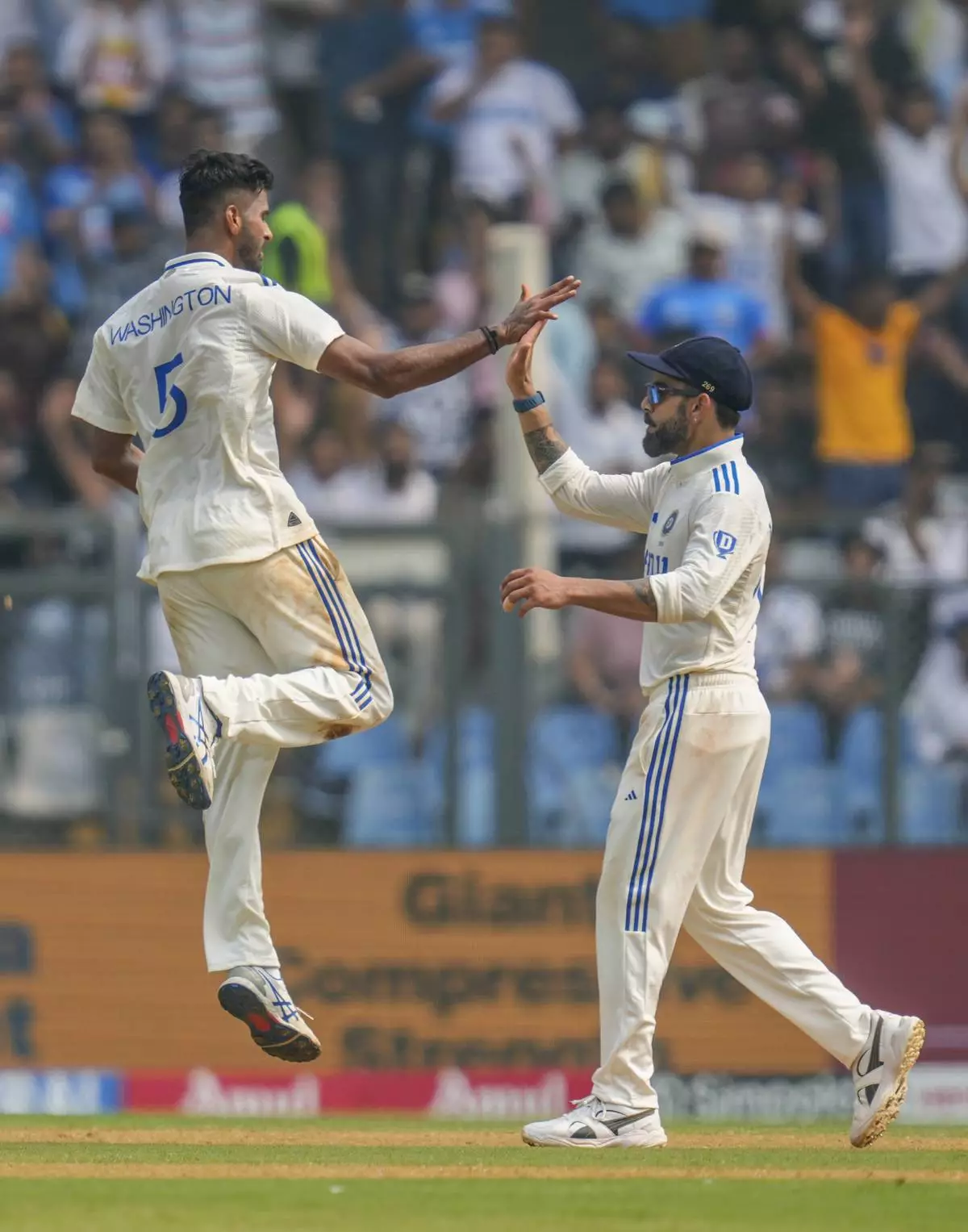
India's Washington Sundar, left, and Virat Kohli celebrates the dismissal of New Zealand's captain Tom Latham during the first day of the third cricket test match between India and New Zealand at Wankhede Stadium, in Mumbai, India, Friday, Nov. 1, 2024.(AP Photo/Rajanish Kakade)

India's Washington Sundar, left, and Virat Kohli celebrates the dismissal of New Zealand's captain Tom Latham during the first day of the third cricket test match between India and New Zealand at Wankhede Stadium, in Mumbai, India, Friday, Nov. 1, 2024.(AP Photo/Rajanish Kakade)
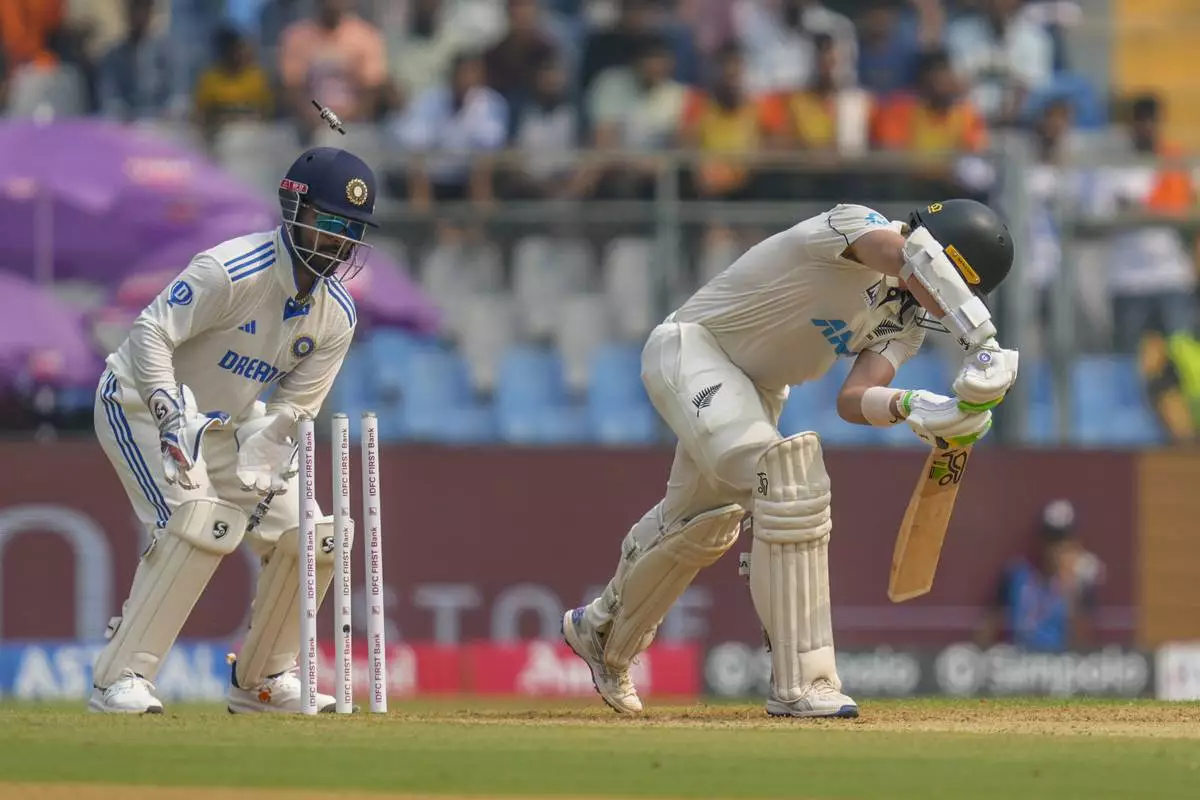
New Zealand's captain Tom Latham is bowled out during the first day of the third cricket test match between India and New Zealand at Wankhede Stadium, in Mumbai, India, Friday, Nov. 1, 2024.(AP Photo/Rajanish Kakade)
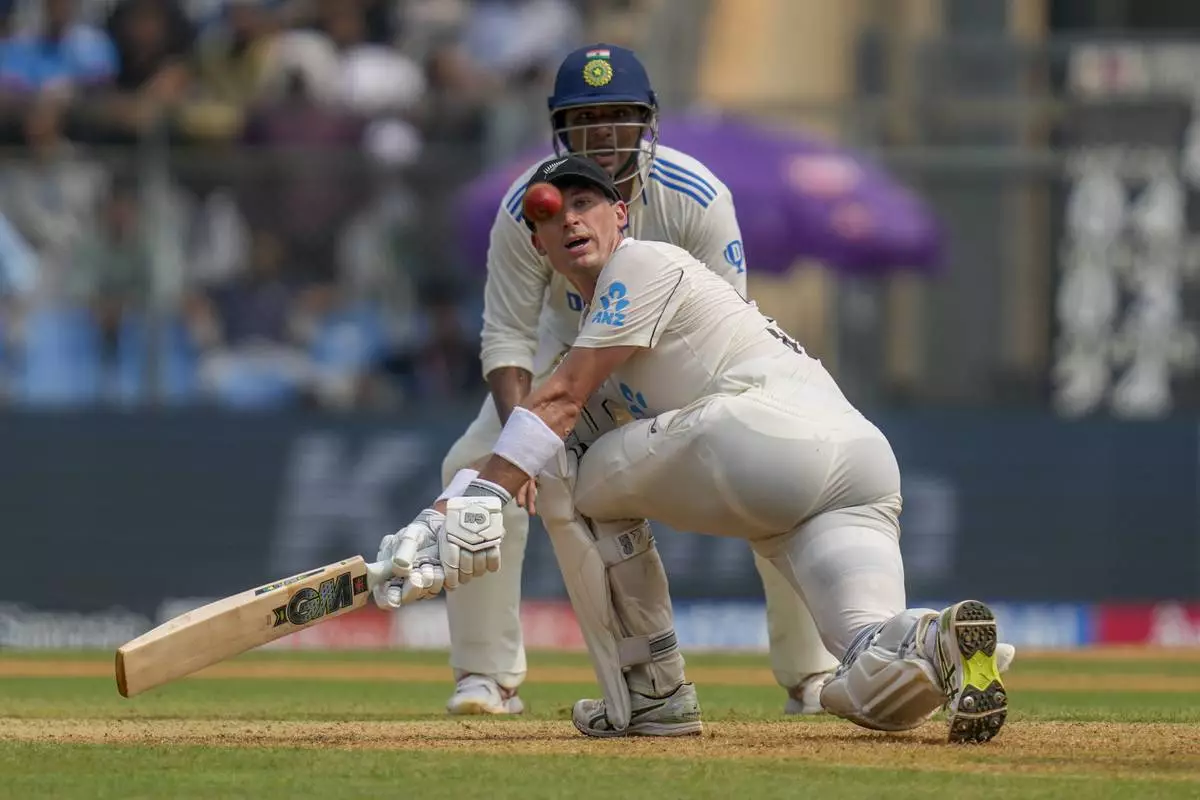
New Zealand's Will Young watches at the ball after playing a shot during the first day of the third cricket test match between India and New Zealand at Wankhede Stadium, in Mumbai, India, Friday, Nov. 1, 2024.(AP Photo/Rajanish Kakade)
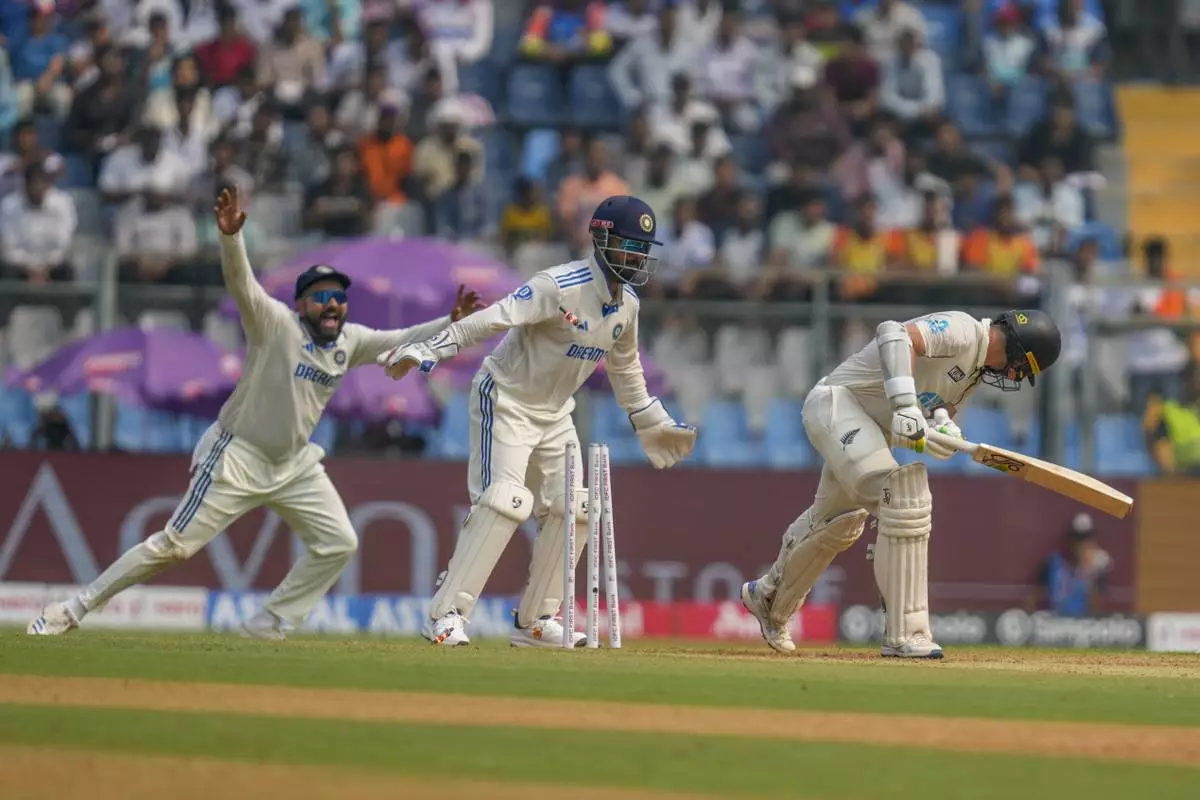
India's captain Rohit Sharma, left, Rishab Pant, center, celebrates the dismissal of New Zealand's captain Tom Latham, right, during the first day of the third cricket test match between India and New Zealand at Wankhede Stadium, in Mumbai, India, Friday, Nov. 1, 2024.(AP Photo/Rajanish Kakade)
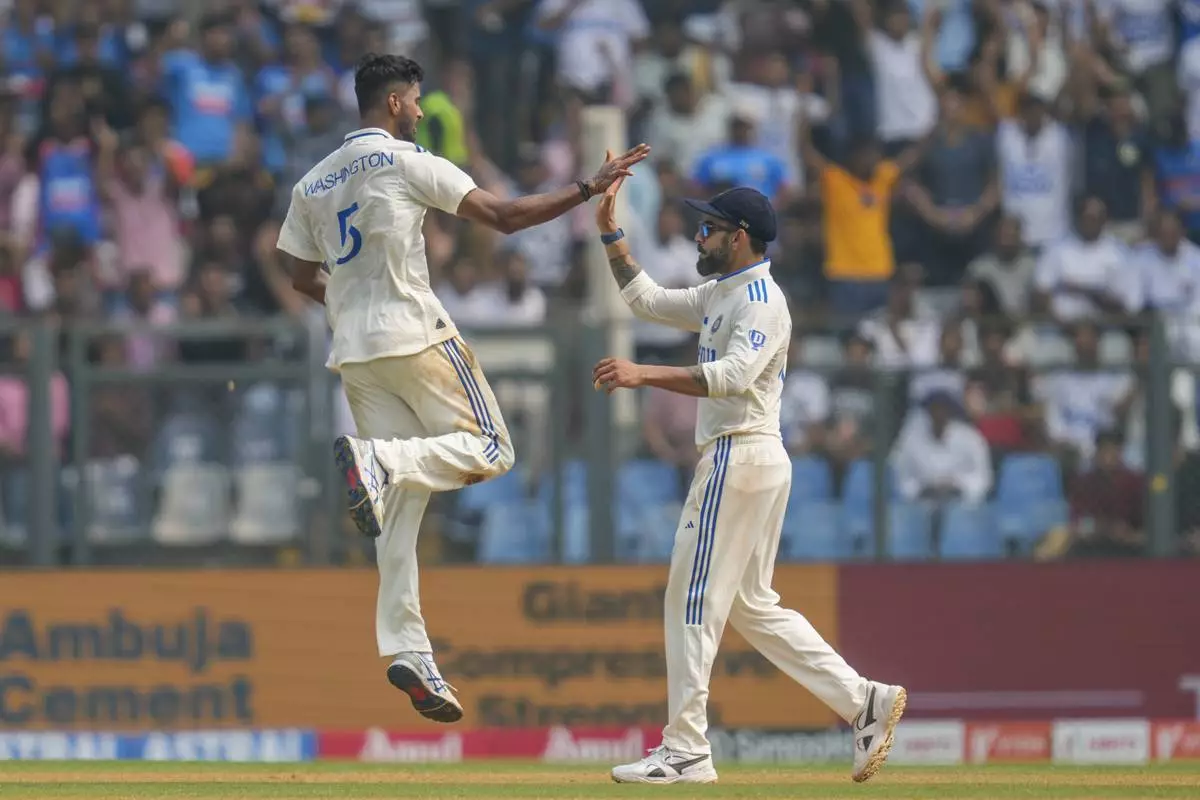
India's Washington Sundar, left, and Virat Kohli celebrates the dismissal of New Zealand's captain Tom Latham during the first day of the third cricket test match between India and New Zealand at Wankhede Stadium, in Mumbai, India, Friday, Nov. 1, 2024.(AP Photo/Rajanish Kakade)
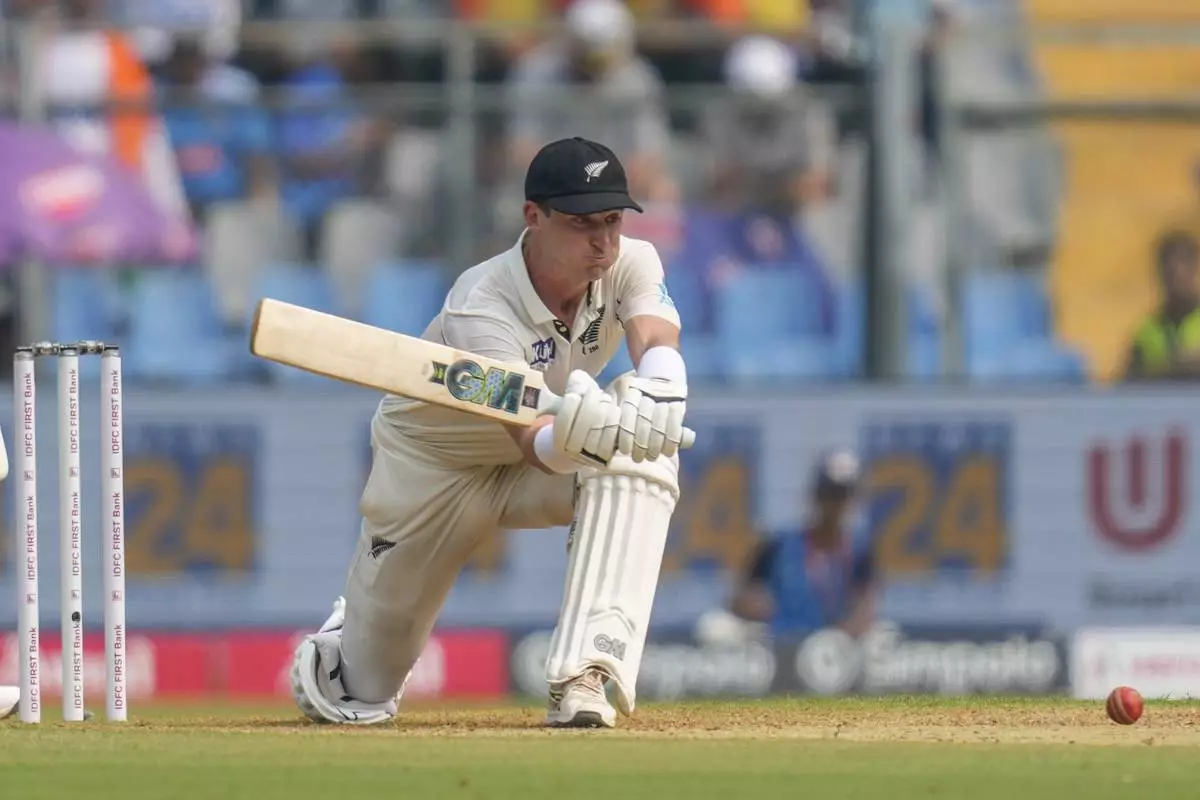
New Zealand's Will Young bats during the first day of the third cricket test match between India and New Zealand at Wankhede Stadium, in Mumbai, India, Friday, Nov. 1, 2024.(AP Photo/Rajanish Kakade)
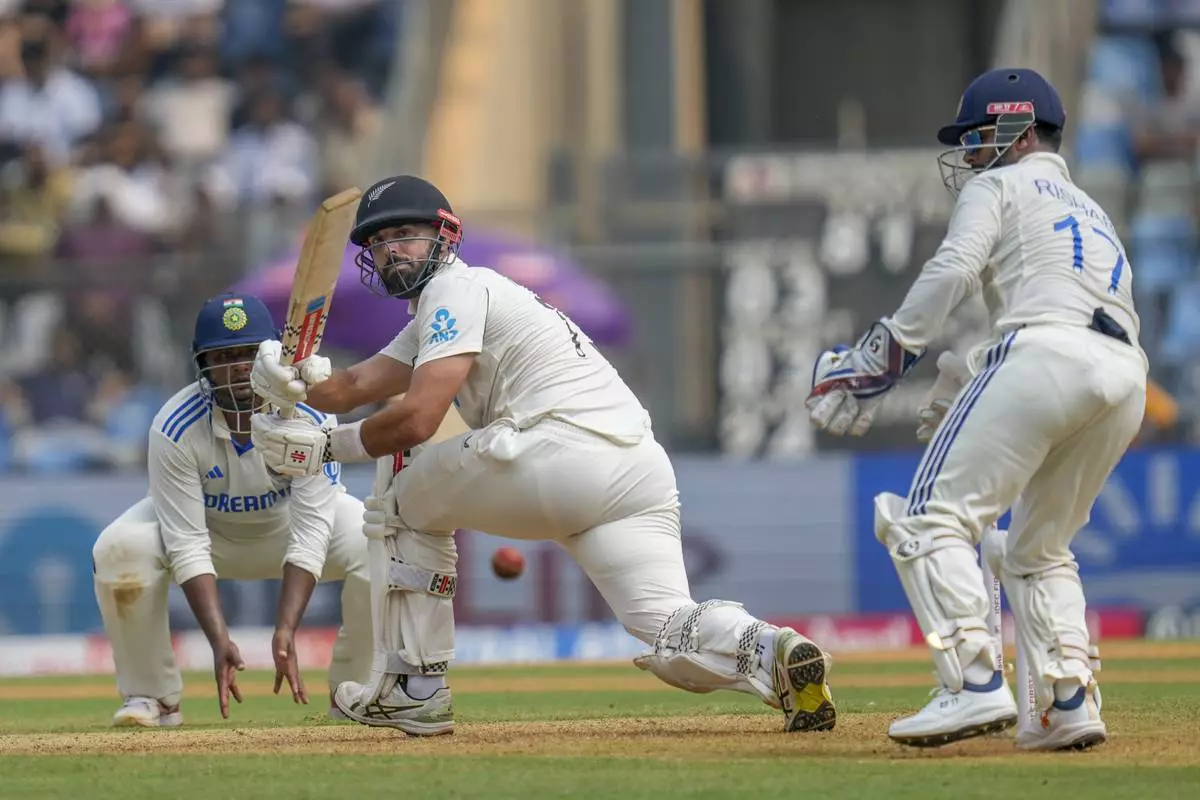
New Zealand's Daryl Mitchell watches at the ball after playing a shot during the first day of the third cricket test match between India and New Zealand at Wankhede Stadium, in Mumbai, India, Friday, Nov. 1, 2024.(AP Photo/Rajanish Kakade)
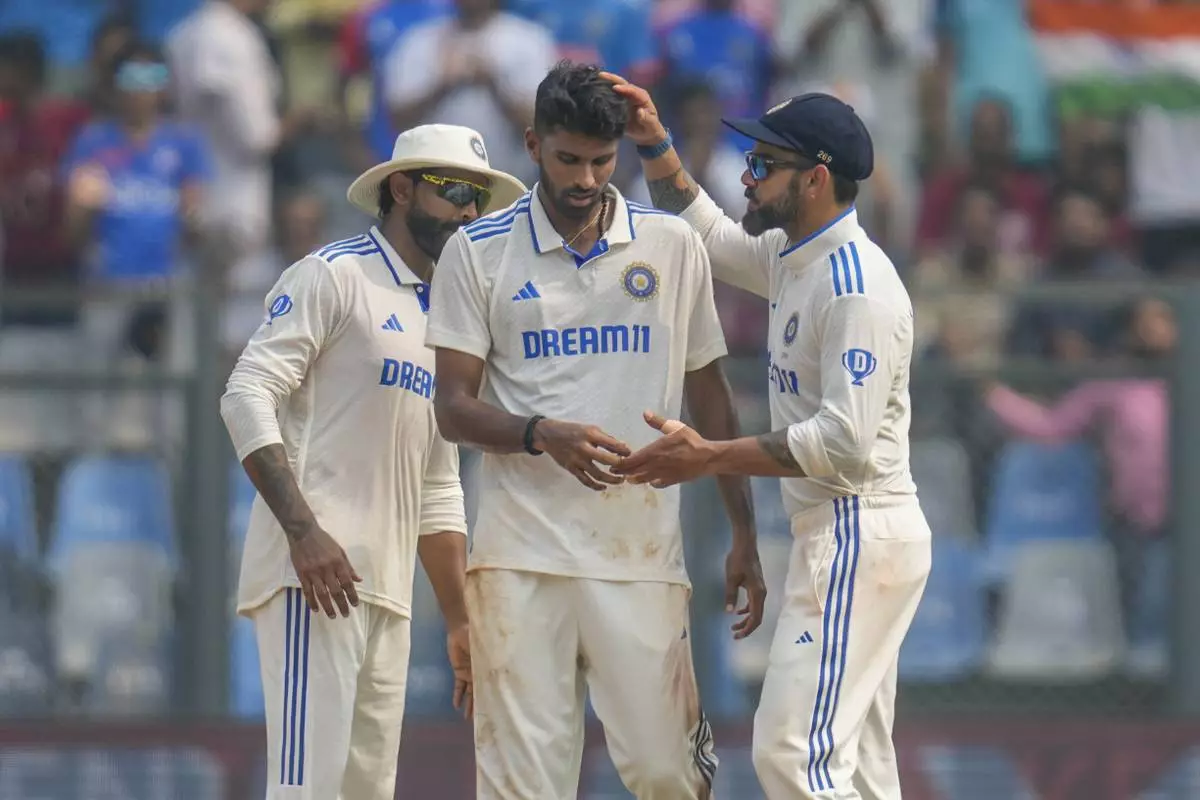
Washington Sundar, center, Virat Kohli, right, and Ravindra Jadeja celebrates the dismissal of New Zealand's captain Tom Latham during the first day of the third cricket test match between India and New Zealand at Wankhede Stadium, in Mumbai, India, Friday, Nov. 1, 2024.(AP Photo/Rajanish Kakade)
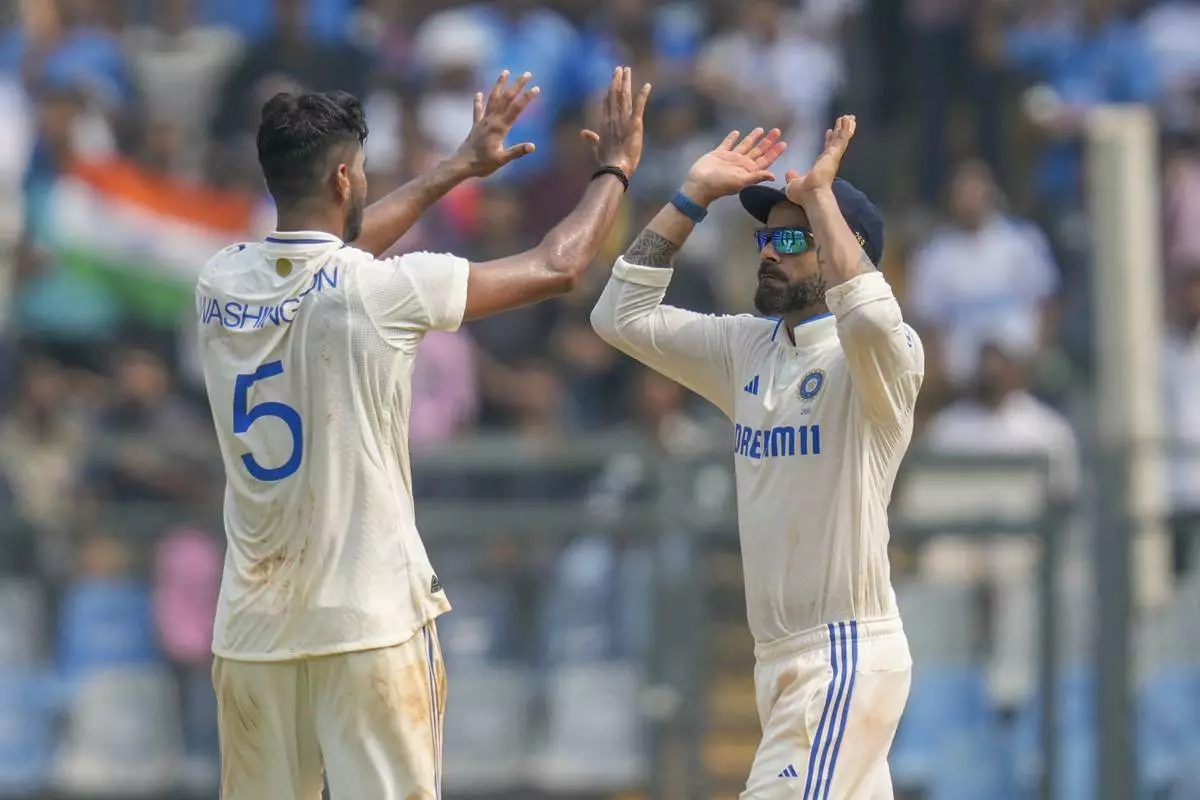
India's Washington Sundar, left, and Virat Kohli celebrates the dismissal of New Zealand's Rachin Ravindra during the first day of the third cricket test match between India and New Zealand at Wankhede Stadium, in Mumbai, India, Friday, Nov. 1, 2024.(AP Photo/Rajanish Kakade)
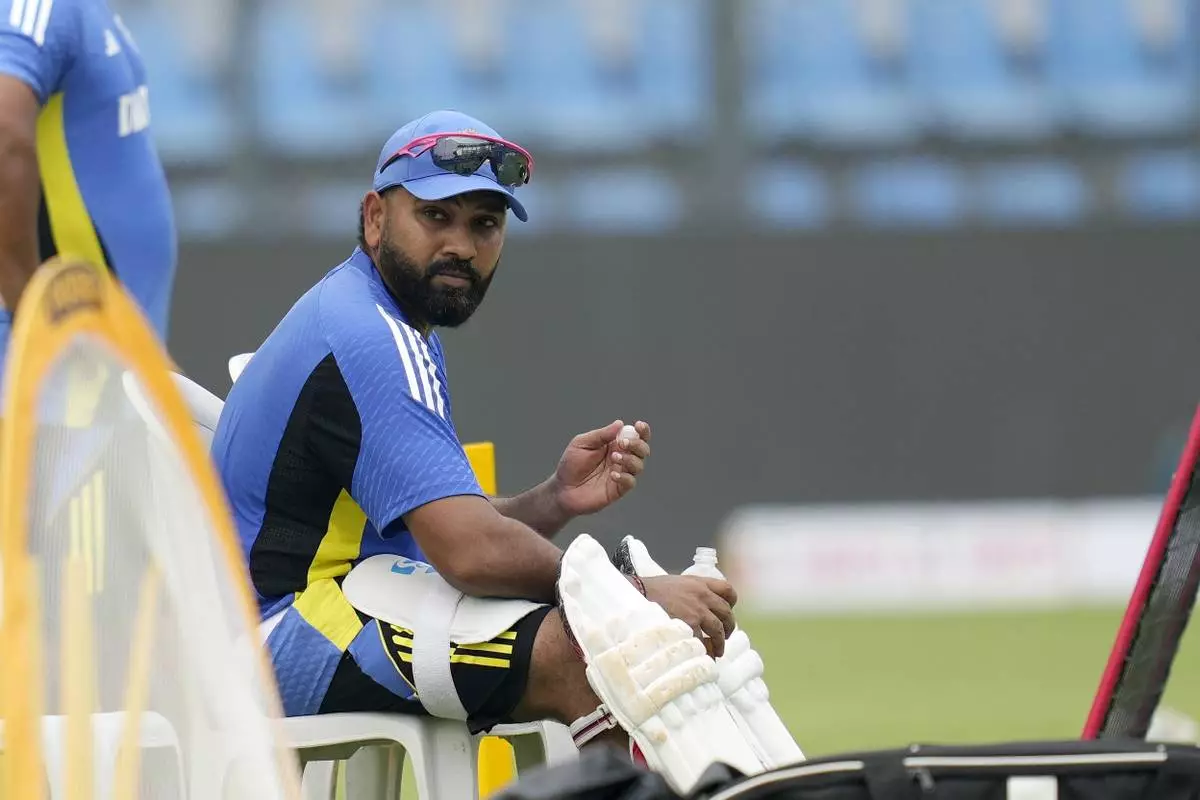
India's captain Rohit Sharma attends practice session before third test match against New Zealand in Mumbai, India, Thursday, Oct. 31, 2024. (AP Photo/Rajanish Kakade)
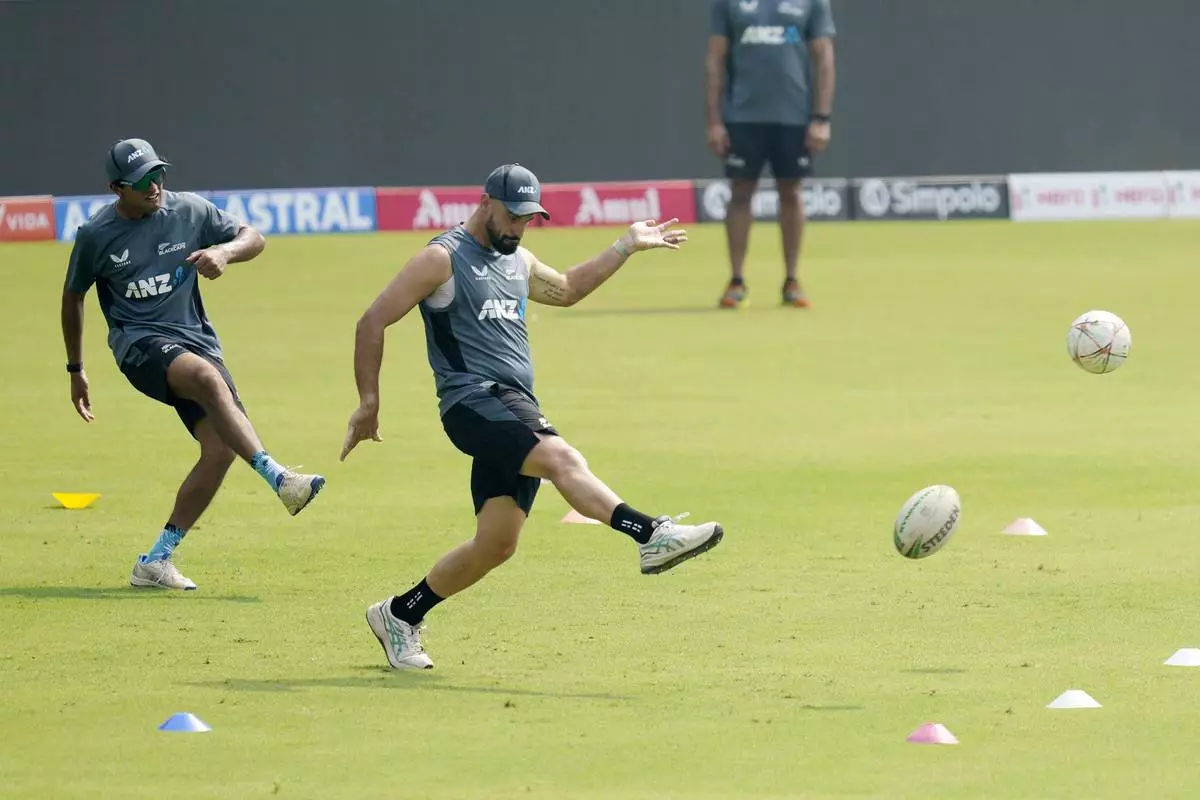
New Zealand's Rachin Ravindra, left and Daryl Mitchell take part in a practice session before the third test match against India, in Mumbai, India, Thursday, Oct. 31, 2024. (AP Photo/Rajanish Kakade)
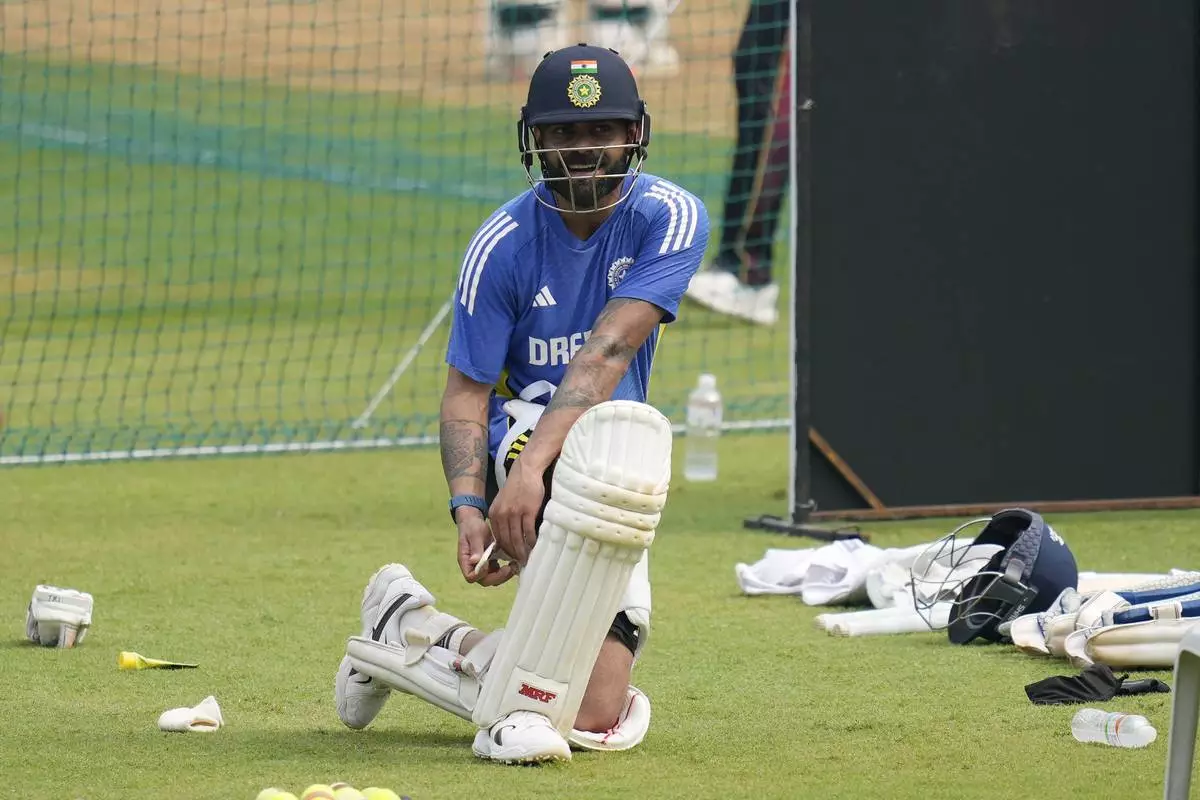
India's Virat Kohli participates in a practice session before third test match against New Zealand in Mumbai, India, Thursday, Oct. 31, 2024.(AP Photo/Rajanish Kakade)

New Zealand's Mitchell Santner takes part in a practice session before the third test match against India, in Mumbai, India, Thursday, Oct. 31, 2024. (AP Photo/Rajanish Kakade)
WASHINGTON (AP) — A federal judge on Tuesday temporarily blocked a push from President Donald Trump to pause federal funding while his administration conducts an across-the-board ideological review to uproot progressive initiatives.
The Trump administration plan plunged the U.S. government — and states and organizations that rely on federal funding — into panic and confusion and set the stage for a constitutional clash over control of taxpayer money.
The order from U.S. District Judge Loren L. AliKhan came minutes before the funding freeze was scheduled to go into effect. The administrative stay, prompted by a lawsuit brought by nonprofit groups, lasts until Monday afternoon and applies only to existing programs.
Administration officials said the decision to halt loans and grants — a financial lifeline for local governments, schools and nonprofits — was necessary to ensure that spending complies with Trump’s recent blitz of executive orders. The Republican president wants to increase fossil fuel production, remove protections for transgender people and end diversity, equity and inclusion efforts.
But a vaguely worded memo issued by the Office of Management and Budget, combined with incomplete answers from the White House throughout the day, left lawmakers, public officials and average Americans struggling to figure out what programs would be affected by the pause. Even temporary interruptions in funding could cause layoffs or delays in public services.
“This sort of came out of the blue,” said David Smith, a spokesperson for the Shawnee Mission School District in Kansas, one of countless districts that receive federal funding. Now they're trying to figure out what it means “based on zero information.”
AliKhan, who was appointed by President Joe Biden, said in halting the freeze, “It seems like the federal government currently doesn’t actually know the full extent of the programs that are going to be subject to the pause."
Jessica Morton, an attorney for the National Council of Nonprofits which brought the suit, said the group has tens of thousands of members around the country that could be affected.
“Our client members have reported being extremely concerned about having to shutter if there’s even a brief pause,” Morton said.
Justice Department attorney Daniel Schwei said the plaintiffs hadn’t identified anyone specifically who would lose funding right away if the pause does go into effect.
Democrats have described the Trump administration’s decision as capricious and illegal. They argued that the president had no right to unilaterally stop spending money appropriated by Congress.
Just minutes after AliKhan ruled, Democratic attorneys general from 22 states and the District of Columbia filed their own lawsuit seeking to block and permanently prevent the administration from cutting off federal funding.
“There is no question this policy is reckless, dangerous, illegal and unconstitutional,” New York Attorney General Letitia James said.
Trump administration officials said programs that provide direct assistance to Americans would not be affected, such as Medicare, Medicaid, Social Security, student loans and food stamps. They also defended the funding pause, saying Trump was following through on his promise to turn Washington upside down if elected to a second term.
However, the effects were being felt far from the nation’s capital. Organizations like Meals on Wheels, which receives federal money to deliver food to the elderly, were worried about getting cut off.
“The lack of clarity and uncertainty right now is creating chaos,” spokeswoman Jenny Young said. She added that “seniors may panic not knowing where their next meals will come from.”
The National Science Foundation postponed this week’s panels for reviewing grant applications. Officials in Prichard, Alabama, feared they wouldn’t receive infrastructure funding to fix their leaking drinking water system. Republican leaders in Louisiana said they were “seeking clarity” to ensure nothing was “jeopardizing financial stability of the state.”
“Trump’s actions would wreak havoc in red and blue communities everywhere,” said Sen. Patty Murray of Washington, the top Democrat on the Senate Appropriations Committee. “We are talking about our small towns, our cities, our school districts.”
The full scope of the administration’s review was spelled out in a 51-page spreadsheet sent to federal agencies and viewed by The Associated Press. Each line was a different government initiative, from pool safety to tribal workforce development to special education.
Officials were directed to answer a series of yes or no questions for every item on the list, including “does this program promote gender ideology?” or “does this program promote or support in any way abortion?” Responses are due by Feb. 7.
Trillions of dollars are potentially under review. Grants that have been awarded but not spent are also supposed to be halted if they might violate one of Trump’s executive orders.
“The use of Federal resources to advance Marxist equity, transgenderism, and green new deal social engineering policies is a waste of taxpayer dollars that does not improve the day-to-day lives of those we serve,” wrote Matthew Vaeth, the acting director of the Office of Management and Budget, in a memo distributed Monday.
Vaeth wrote that “each agency must complete a comprehensive analysis of all of their Federal financial assistance programs to identify programs, projects, and activities that may be implicated by any of the President’s executive orders.” He also wrote that the pause should be implemented “to the extent permissible under applicable law.”
The pause on grants and loans was scheduled to take effect at 5 p.m. ET, just one day after agencies were informed of the decision.
The issue dominated the first briefing held by White House press secretary Karoline Leavitt. She said the administration was trying to be “good stewards” of public money by making sure that there was “no more funding for transgenderism and wokeness.”
She denied that Trump was deliberately challenging Congress to establish his dominance over the federal budget.
“He’s just trying to ensure that the tax money going out the door in this very bankrupt city actually aligns with the will and the priorities of the American people,” she said.
The Environmental Protection Agency confirmed that it would implement the pause to “align federal spending and action with the will of the American people as expressed through President Trump’s priorities.” The Department of Energy also said it was conducting a review of its spending.
The funding pause is the latest example of how Trump is harnessing his power over the federal system to advance his conservative goals. Unlike during his first term, when Trump and many members of his inner circle were unfamiliar with Washington, this time he’s reaching deep into the bureaucracy.
For example, federal employees are being asked to report their colleagues if they try to continue diversity, equity and inclusion initiatives.
“They are pushing the president’s agenda from the bottom up,” said Paul Light, an expert on the federal government and professor emeritus of public service at New York University.
He also said there are risks in Trump’s approach, especially with so many voters reliant on Washington.
“You can’t just hassle, hassle, hassle,” Light said. “You’ve got to deliver.”
Fears about interruption in government services were exacerbated as states reported problems with the Medicaid funding portal, where officials request reimbursement for providing healthcare to poor residents.
Democrats condemned the Trump administration, connecting the issue to the funding pause.
But Leavitt said the portal would be back online soon.
“We have confirmed no payments have been affected — they are still being processed and sent," she posted on social media.
Associated Press writers JoNel Aleccia, Moriah Balingit, Collin Binkley, Matthew Daly, Lisa Mascaro, Adithi Ramakrishnan, Amanda Seitz, Michael Sisak, Lindsay Whitehurst and Tammy Weber contributed to this report.

People protest against a funding freeze of federal grants and loans following a push from President Donald Trump to pause federal funding near to the White House in Washington, Tuesday, Jan. 28, 2025. (AP Photo/Ben Curtis)
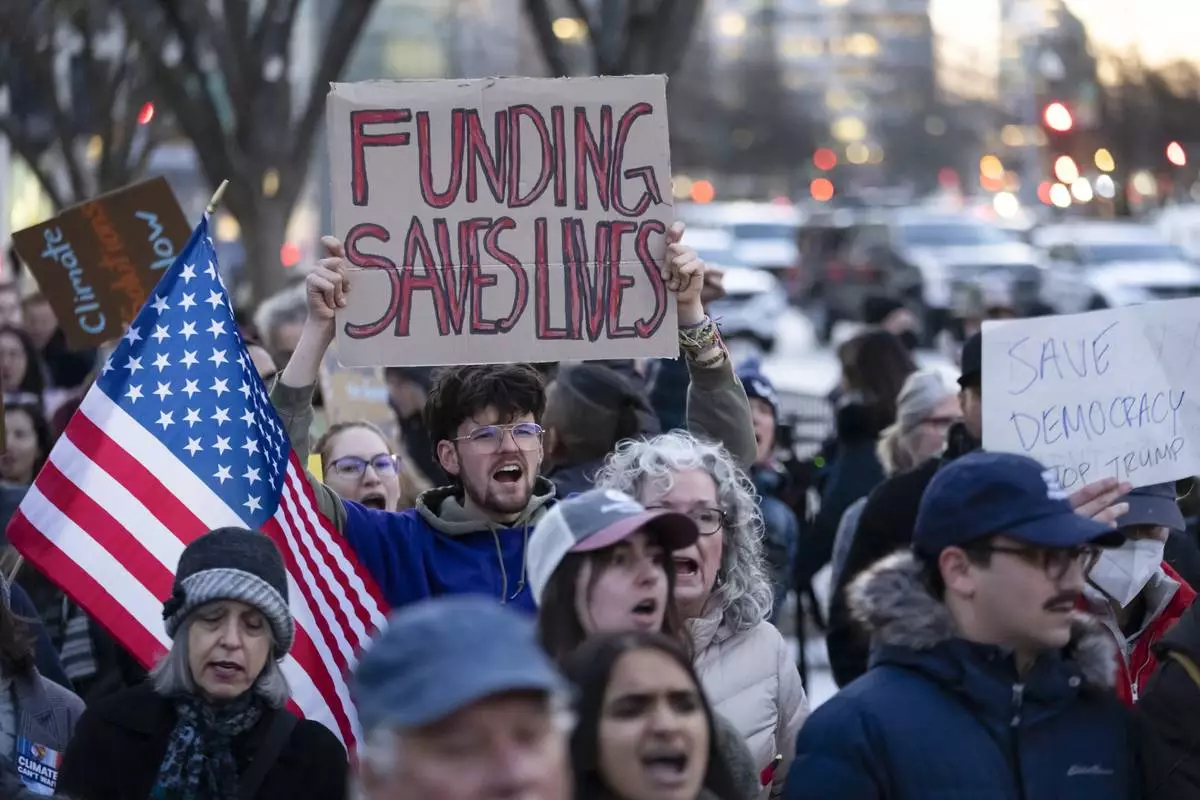
People protest against a funding freeze of federal grants and loans following a push from President Donald Trump to pause federal funding near to the White House in Washington, Tuesday, Jan. 28, 2025. (AP Photo/Ben Curtis)

People protest against a funding freeze of federal grants and loans following a push from President Donald Trump to pause federal funding near to the White House in Washington, Tuesday, Jan. 28, 2025. (AP Photo/Ben Curtis)

People protest against a funding freeze of federal grants and loans following a push from President Donald Trump to pause federal funding near to the White House in Washington, Tuesday, Jan. 28, 2025. (AP Photo/Ben Curtis)

People protest against a funding freeze of federal grants and loans following a push from President Donald Trump to pause federal funding near to the White House in Washington, Tuesday, Jan. 28, 2025. (AP Photo/Ben Curtis)

People protest against a funding freeze of federal grants and loans following a push from President Donald Trump to pause federal funding near to the White House in Washington, Tuesday, Jan. 28, 2025. (AP Photo/Ben Curtis)

President Donald Trump speaks to reporters aboard Air Force One en route from Miami to Joint Base Andrews, Md., Monday, Jan. 27, 2025. (AP Photo/Mark Schiefelbein)




















